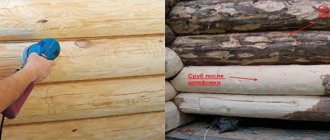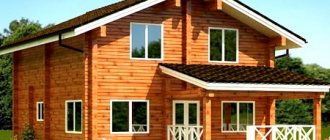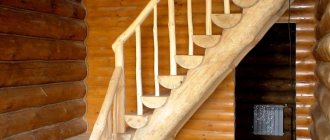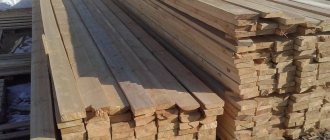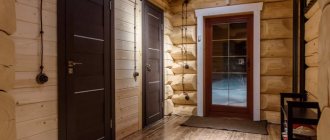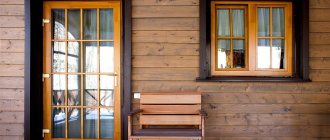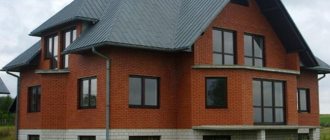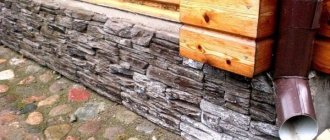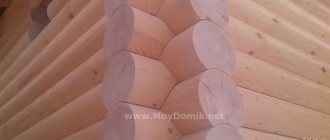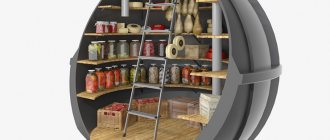Real estate
00:00, 01/04/2021 6 Plot: House in focus
Metal spoon, iodine and other tricks
Photo: stroim-35.ru
Despite the obvious advantages of laminated veneer lumber and other types of “modified” wood, many still prefer regular round logs when building a house. Even more often, a log house is chosen for building a bathhouse. A reasonable approach is to buy not individual logs, but the entire log house. This is a good way to save time and maintain at least some order on the construction site. Today we’ll talk about the basic principles and approaches to choosing a log house.
Types of log cabins
To build log cabins, a careful preparation of a set of materials is required. The main elements of a wooden structure in a log house format, by modern standards, are round timber or timber. When preparing, it is important to consider the degree of drying of the material or the condition of the material leaving the sawmill after direct cutting. Carpenters prefer planing logs or expertly debarked trunks. Log houses are often built using a carriage - blanks hewn with a cleaver (parallel on both sides). Material of natural moisture is not used in the construction of turnkey houses. For these works, material dried in drying chambers is used using specialized technologies. The forms of popular log houses are represented by the following types:
- Quadruple - rectangular design;
- Octagon - an octagonal frame;
- Shesterikom - hexagonal building;
- Gorodnya - a log house with structural filling with stone;
- Five-wall - a structure with the arrangement of an auxiliary wall (partition);
- Povalushey - a large-sized log house in the tower format.
Modern log houses differ in the technology of cutting corners and the unique specifics of construction. Briefly about technology
Traditional rules of wooden architecture are subject to change with the development of modern technologies. In the modern outlines of log houses, technologically advanced structural units with improved technical elements have appeared. The construction of a high-quality log house begins with dense laying of log rows. The laid rows of a log structure are indicated by crowns. The bottom row of logs is called the mortgage. Subsequent rows of crowns are considered overlapped. For each log, characteristic grooves and locking corner joints are arranged. Preliminary drying of the wood material replaces the shrinkage of the log house and allows for immediate finishing (not after 12 months). For finishing finishing, dried materials (imitation timber) are also recommended.
Cutting "in the tail"
This method of manual cutting is the same bowl, but improved. Corner structures have a more complex configuration - the presence of an additional spike called a fat tail. It allows you to form a stronger and tighter connection. In this case, the recess (bowl) can be oriented both up (traditionally) and down.
The type of log cutting “in the tail” makes it possible to avoid the wind blowing through the walls of the house. A home built in this way is warmer, more comfortable, and has less heat loss.
Comparative characteristics of types of log houses
For a correct assessment and understanding of log houses, it is necessary to study the types of corner chopped joints (lock joints). Corner cutting is considered the main element in the construction of log walls. Different types of cabins are characterized by: the complexity of design options, the required set of parts and the practicality of the lock (heat saving). Corner joints are characterized by 2 types of cutting: – without residue (to the paw) – oblique (dovetail) and straight; – with the remainder (in a bowl or bowl).
Device in the paw
The claw connection is characterized by its advantages. This construction significantly reduces the cost of expensive wood and overall construction costs. The future premises are distinguished by outer rectangular corners and a larger area compared to the chopping block. The main disadvantage is the reduced strength of the connection. The log house is blown and is critical to the effects of climatic conditions. Additional external cladding is required to eliminate deficiencies.
Device in a bowl
When cutting with release or residue, a longitudinal groove is created in the bottom log. Here a special bowl is cut in the form of a semicircular cavity for laying transverse logs. The method is not labor-intensive for creating the upper lunar groove - the log does not need to be turned over. This method is characterized by its own set of disadvantages. The performance properties of the connection when the bowl is positioned upward are reduced by poor protection from atmospheric phenomena. Moisture in the bowl and inter-crown groove joint wets the insulation, the result is gradual rotting. The plane of the bowl connection is easily blown through when the logs dry out naturally. A good bathhouse is practically not sold. Periodic caulking of gaps is required. Other types of devices are represented by cutting: In the chopping block. The inverted version of chopping into a bowl is known to experts as ohlupen. The nuance lies in the design of the inter-crown groove with a bowl, which are located in the lower roundness of the upper log. Stable corner connection against falling precipitation. The work requires increased labor costs with skillful execution. The logs are repeatedly turned over during careful adjustment; In the fat tail. Connection with a structurally improved bowl, in which a structural spike is installed - fat tail. A groove is made on the directly opposite part of the log to accommodate the tenon of the subsequent log. Indicative strength and corner sealing with the exception of blowing; Canadian. The design features are similar to the fat tail device, with a significant difference in the shape of the connection. The Canadian version, in contrast to the rounded Russian bowl, is represented by a trapezoidal notch - selected at the bottom of the log.
Two hundred and one defect
When choosing a log house, the main thing is to make sure that it is made of suitable material, because, of course, logs are different from logs. To begin with, you can arm yourself with knowledge about visible defects in logs, which number not even in tens, but in hundreds.
Even a seemingly ordinary knot (when a branch grows into the body of a log, and when cut, a characteristic round pattern is obtained) has 27 varieties. Visible wood defects are described in a separate document - an interstate standard, which is based on several GOSTs. This is a very fascinating read: in addition to 27 types of knots, here you can get acquainted with 17 types of cracks, 57 types of trunk defects, 5 types of chemical stains (including those resulting from drying), 23 types of fungal infections and rot, 11 types of biological damage (including wormholes and damage caused by birds), 34 types of mechanical damage to wood and 7 types of warping.
And then this interesting document describes in detail how all these defects are measured and how to properly classify them. There are also detailed drawings from which you can learn to distinguish wood defects. Separate chapters are devoted to round timber (this is what interests us when choosing a log house), veneer and lumber (these chapters will also definitely come in handy a little later, when you start finishing and deal with interfloor ceilings and other “wooden” construction work).
Photo: sekretymastera.ru
A humorous warning: if you are planning to build a wooden house, then you should read this standard in detail only if you have strong nerves - so that it doesn’t turn out like Jerome Klapka’s hero Jerome, who read a medical encyclopedia and, as a result, found everything described in it. diseases other than puerperal fever. However, it also contains reassuring information: not all types of visible wood defects affect its performance properties. Many of the two hundred defects described affect only the outside, in appearance.
Heat loss during winter operation of the house for each type of log
According to professionals, a significant percentage of heat loss occurs on the walls of buildings. The loss rate increases with noticeable external and internal temperature changes. The amount of heat loss in winter is reduced by correct selection of wood with the best thermal conductivity. Different wood densities have a direct effect on heat loss. When making calculations, craftsmen use the concept of heat transfer resistance ® - a value that characterizes the heat-shielding qualities of wood. With known temperature differences, the heat loss characteristic (Q) helps to estimate the amount of heat lost per 1 m² of wall. Calculation of heat loss is carried out according to the formula - Q = S * ΔT/ R, where: ‣ Q - Quantitative expression of losses; ‣ R—heat transfer resistance; ‣ S—structural area of the building; ‣ ΔT - external and internal temperature difference.
What parameters of logs need to be taken into account?
Logs of various tree species are used to build walls for bathhouses, country houses and other buildings. The most popular of them are coniferous species (cedar, pine, spruce, larch). The appearance of the structure, its quality and performance properties, as well as the price of the planned construction, depend on well-chosen wood.
The highest quality are considered to be northern types of pines (Leningrad, Karelian, Finnish), which are cut down in winter.
At this time, the wood is maximally saturated with resins, less affected by parasites and contains a minimum of moisture.
To make it easier to erect a structure, the material must be calibrated - this will help make more accurate calculations during the project and minimize “adjustment”.
When choosing a log for construction, you should clarify the humidity parameter - it should not be higher than 22%. The material can be dried or have natural moisture. The lower the humidity level, the sooner shrinkage will occur, and finishing work can begin.
For the construction of walls, logs with a diameter of 140 to 320 mm are produced. For country houses that are used in the warm season, without the use of heating devices, logs with a diameter of 140-200 mm are suitable. The same blanks can be used for small buildings.
For houses being built in central Russia with a total area of 250 sq.m., wood with a cross-section of 220-280 mm is suitable, as it can withstand heavy loads.
Material with a diameter of 280 mm is used mainly in the northern regions . Such logs are most often used to decorate a building, as well as to emphasize its individuality and originality, and are placed in certain places of the building.
Practicality and cost of building a house (capital costs for construction)
A high-quality house using specially dried material has higher prices. Unscrupulous builders who carry out turnkey work often use raw lumber and promise to complete construction in 3–4 months. Windows and doors are cut in with increased gaps with the expectation of being blown in with foam.
When working with material of natural moisture, it subsequently squeezes out and warps the slopes. High-quality expensive finishing is distorted. A scrupulous developer needs to competently approach the practicality of a log house made from a specific material.
Types of sealants for log joints.
Our website presents a number of log house projects, for example: Or you can see all prices for log houses. You can calculate the house or bathhouse you need with maximum accuracy using our log house cost calculator. To order and buy a log house, call:
- Vologda
- Moscow,
Comments
No comments yet.
leave a comment
Also read with this material:
- Log house for a plane: processing features and durability of construction
- House and bathhouse from a carriage, pros and cons: turnkey construction, log houses from a carriage https://www.domastroim.ru/dom-i-banya-iz-lafeta-plyusy-i-minusy-stroitelstvo-pod-klyuch-sruby- iz-lafeta/
- Treatment of a log house with linseed oil: comparison with other types of impregnations https://www.domastroim.ru/obrabotka-sruba-lnyanym-maslom-sravnenie-s-drugimi-vidami-propitok/
Treatment inside the bath
The log house needs protection from all sides , but from the outside it is simpler, more precisely, there simply are not the restrictions that apply inside, since we are talking about a bathhouse. The fact is that the compounds that should be used for processing are often poisonous, especially for antiseptic impregnations. And the sauna is hot and humid, so the substances with which the logs are soaked will enter the air you breathe, which surrounds your skin.
Therefore, now we will only talk about the acceptable processing of logs inside the bathhouse. However, it will differ depending on the premises. So for the dressing room or hallway there are no restrictions on the use of toxic antiseptics. The rest room can also be treated with them.
ADVICE! When choosing an antiseptic for interior work, check with the seller or Google that we are talking about a bathhouse.
In
the washing room , you should use compounds that are not afraid of water, and most antiseptics are water-soluble.
In the steam room , you can use chlorine-based bleach - it will both lighten the surface of the wood and serve as an antiseptic. You can use the steam room only after the smell of bleach disappears.
In the future, you can do simple moisture protection, because mold settles on damp wood. For moisture protection, use oil and/or wax-based compositions, or Finnish acrylic sauna varnishes, to which they add antiseptics acceptable for steam rooms.
The seams can be filled with wood sealant , and the surface of the logs can simply be sanded to reveal a beautiful “moiré” texture. Painting is acceptable almost everywhere, but in the steam room you should use only those paints that are intended for it. Paints suitable for bathrooms will work in the washroom. We have a detailed section about bath paints.
How to caulk
The idea of caulking a bathhouse made of logs suggests that not all bathhouse owners are familiar with modern means of sealing joints (or do not consider them the best). Traditional methods, of course, are time-tested, but they are very labor-intensive and require periodic labor-intensive updating, since the log house is constantly gradually changing its dimensions during the first 20 years of life.
As for materials, are usually used for caulking . However, below we will provide a link to a video of a master who categorically does not recommend caulking with jute, because it absorbs moisture well. He considers flax wool to be the optimal material. Moss is traditional, but not widespread everywhere.
Tow comes in different qualities. The worse one has inclusions of all kinds of straw. Masters also do not recommend using it, because some of it will crumble over time. Good quality flax tow is an excellent material for caulking.
Linen batting is a quilted fabric that is somewhat reminiscent of jute, but differs from it in quality. It is convenient for work and is not inferior to tow in terms of heat-insulating properties.
See also: Are we installing a log house or timber? Interventional insulation for a bathhouse: which one to choose, which is better, natural or modern?
There are two different methods for placing caulking material in the cracks between logs. The first is called “pigtail” or “stretch”, the second “set”. Watch videos that show how the masters work.
Caulk with moss:
Pakley:
Lnovatin:
